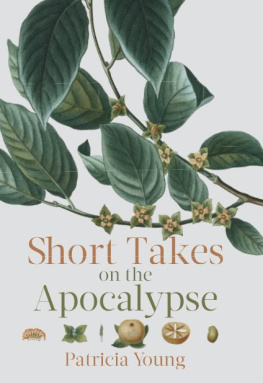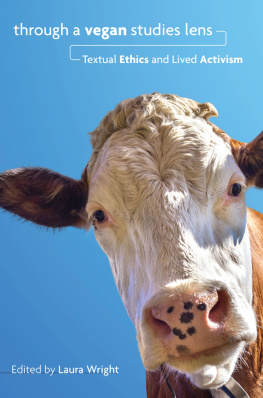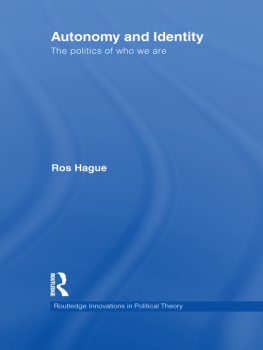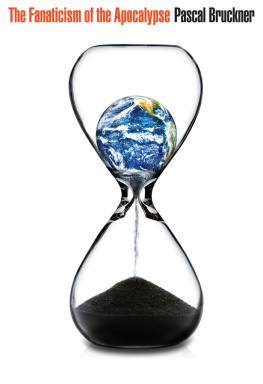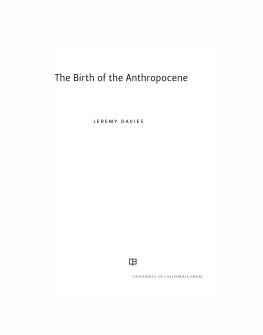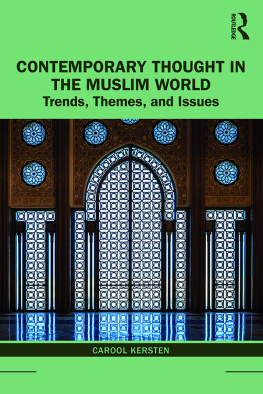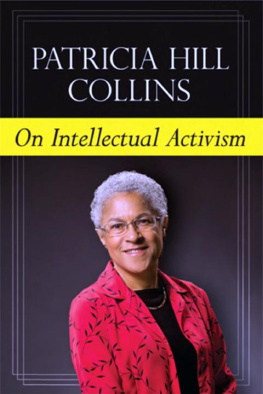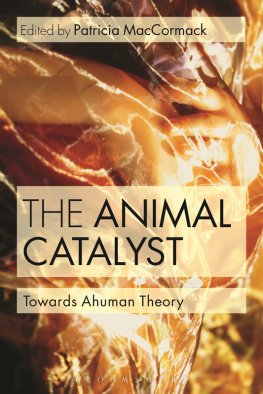
THE AHUMAN MANIFESTO
THE AHUMAN MANIFESTO
Activism for the end of the anthropocene
PATRICIA MACCORMACK

BLOOMSBURY ACADEMIC
Bloomsbury Publishing Plc
50 Bedford Square, London, WC1B 3DP, UK
1385 Broadway, New York, NY 10018, USA
BLOOMSBURY, BLOOMSBURY ACADEMIC and the Diana logo are trademarks of Bloomsbury Publishing Plc
First published in Great Britain 2020
Copyright Patricia MacCormack, 2020
Patricia MacCormack has asserted her right under the Copyright, Designs and Patents Act, 1988, to be identified as Author of this work.
For legal purposes the Acknowledgements constitute an extension of this copyright page.
Cover design by Charlotte Daniels
Cover image Shakzu / Getty Images
All rights reserved. No part of this publication may be reproduced or transmitted in any form or by any means, electronic or mechanical, including photocopying, recording, or any information storage or retrieval system, without prior permission in writing from the publishers.
Bloomsbury Publishing Plc does not have any control over, or responsibility for, any third-party websites referred to or in this book. All internet addresses given in this book were correct at the time of going to press. The author and publisher regret any inconvenience caused if addresses have changed or sites have ceased to exist, but can accept no responsibility for any such changes.
A catalogue record for this book is available from the British Library.
A catalog record for this book is available from the Library of Congress.
ISBN: HB: 978-1-3500-8109-3
PB: 978-1-3500-8110-9
ePDF: 978-1-3500-8111-6
eBook: 978-1-3500-8112-3
To find out more about our authors and books visit www.bloomsbury.com and sign up for our newsletters.
ALSO AVAILABLE AT BLOOMSBURY
Ecosophical Aesthetics: Art, Ethics and Ecology with Guattari , ed. Patricia MacCormack and Colin Gardner
Posthuman Glossary , ed. Rosi Braidotti and Maria Hlavajova
General Ecology: The New Ecological Paradigm , ed. Erich Hrl, with James Burton
Philosophical Posthumanism , Francesca Ferrando
The Last Humanity: A New Ecological Science , Franois Laruelle (forthcoming)
For Circe and Francesco
CONTENTS
Thank you to Liza Thompson and Frankie Mace at Bloomsbury for encouraging me to write this and agreeing to take such a sympathetic risk. Thank you to the many scholars who live their philosophies. These include, but of course are not limited to, those who have read and helped me with this book, including Colin Gardner (with whom I hope to write much more), Ruth McPhee, Chrysanthi Nigianni, Marietta Radomska, Claire Colebrook, Meredith Jones, David Rodowick, Phil Hine, Christina Oakley-Harrington, renee hoogland, Margrit Shildrick, Nina Lykke, Rosi Braidotti, the Queer Death Studies Network, the Posthumanities Hub and the Animal Catalyst Network. This book celebrates the memory of my dear Jane and Steve Ash, and the support of my beloved Gabriel.
This book is a book which calls for action. Direct, available and immediate action. It is not an academic treatise which seeks to deconstruct contemporary issues with which the earth grapples. It does not search for a balanced, care for and in this world.
The end of the anthropocene (which I will deliberately not capitalize) is the opening of the world. We are beyond questions of why, as it is clear the anthropocene benefits very few living systems and relations. Complicity with the anthropocene has slowly diminished through the vital affirmative work that seeks to destroy the order of knowledge which perpetuates its own values through its claims to truth. The arenas of contestation have remained within anthropocentric discourse, which is the most sinister element of the anthropocenes limitations on activism. It makes the whole natural world the differend , that nonhuman, nonincluded other who cannot speak or cannot be heard. The death of the anthropocene opens up thousands of voices, trajectories, relations and necessary activisms. I use death here as it will be used in the entire manifesto: both advocating for the deceleration of human life through cessation of reproduction, thus death of humans (though, as will be made clear, with care as we live out the lives we have), and the absolute end of perception that apprehends all living organisms and relations through anthropocentric-signifying systems. Activism has long affirmed that forsaking power within the system which constitutes it is the way to change it, and forsaking our human privilege is a way to forsake the anthropocene in order to affirm the world. Activism towards nonhumans and the cessation of bringing new humans are two suggestions, but circumstance will open up radical possibilities that will make the human unthinkable. We are in an age of small tactics, of minor radicalisations, of thinking of ways beyond and ways out, not for ourselves, but for the world. Unlike other revolutions which usually seek to liberate the we as specific collective groups, the contemporary world is dividing humans into two, an overwhelming and growing anthropocene, and what I term the ahuman .
Why manifesto?
This book, like most manifesti, sets out declarations at the intersection of culture, natural contract. We humans are simply parts of a thing known as earth.
For many, the idea of the cessation of human existence as an absurd claim prevents any engagement with both its possibility and its validity. This is understood as being the immediate response to The Ahuman Manifesto . If the history of philosophy itself has been a somewhat narcissistic but also politically invaluable tool in knowing human subjectivity, where often posthumanism is simply a different perpetuation of humanist egoism, then even the death of human exceptionalism is unthinkable. There is nothing martyr-like about devaluing humanity. Ending the privileging of humanity may for some lead to suicide and for others to antinatalism, but neither is a privation demanding acclaim. The greater effects of human absence are more important than dying for a cause, so configuring human absence as martyrdom returns the activism to anthropocentrism. Just as the other is sacrificed for human ends in countless human practices without consent, without a contract and thus can only be called a martyr by the perpetrators to ameliorate guilt, a manifesto that calls to action is not asking for martyrs because ahumans are willing and vitalistic parts of the assemblage, each with a singular and unrepeatable capacity to act and activate differently. This manifesto is emphatically optimistic and life-affirming; it simply sees the distribution of the value of life differently to the anthropocentric understanding of the world. This is not an uncommon belief, and just as we see passed ages perpetrate practices whose end seemed unconceivable at the time human sacrifice, slavery, the denial of women to vote and other practices whose end seems nigh the illegality of homosexuality in many countries, the denial of entry for refugees into developed countries, climate change denial the declarations in this book are what a large and diverse collective of activists see as inevitable. A world where humans did not need to do objectionable and violent things and yet did is how we continue to see the past, while acknowledging we still practice human violence, albeit in different forms. This manifesto shares most of its political aims with what is currently known as antinatalist, abolitionist, atheist veganism, which is a growing collective. But I find inspiration in creativity and imagination that is necessary in thinking the unthinkable, which is why the role of occulture and art also play a part in this manifesto. From an external perspective, antinatalist abolitionism can seem only about reactive or privative forces not doing. It is far from this, which is why I see it belonging to a manifesto as a summoning to creativity. This political arena finds joy in altering the way we as humans occupy the world, and it is not surprising that it retains connections with environmentalism and other deep ecology movements as well as feminism, anti-racism, queer and minoritarian politics of all kinds. It does not lament, it does not mourn for the demise of the human. It takes on the task that does seem impossible, the end of humans. Shouldnt all manifesti deal with what seems impossible? The intimacy between art and political manifesti evinces the relationship between radical creative thought and political change as a single expression of unthinkability, or incompossibility, or whatever posthuman expression could be used which leaves anthropocentrism behind. All manifesti ask is how to express differently to create different affects which can reverberate across multiple relations so affects are created in order to open potentia rather than repeat or close off systems of potestas. Art seeks the same practice. From an anthropocentric point of view, I am speaking of many ends the end of identity, the end of religion, the end of self-serving political movements, the end of human life, the end of the anthropocentric world ultimately the end of humans violent occupation of Earth. As David ONeill states,
Next page


